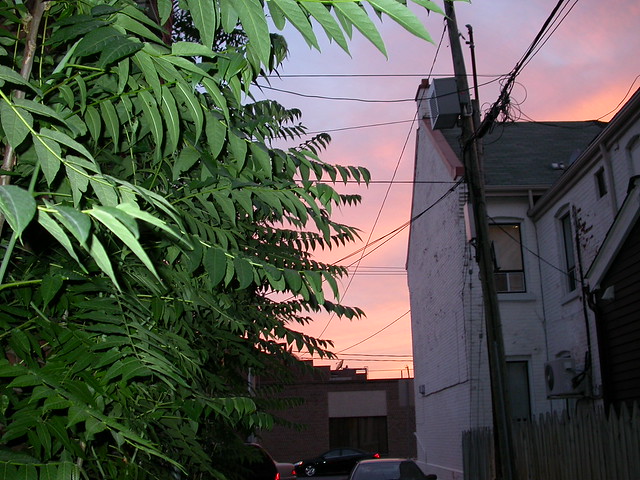
It’s that annual time in June when the city becomes a fertile, fecund, festering flood of steamy spoors, stamens and swampy olfactory inducing elements so thick and organic it seems like we’re living inside a raunchy botanical porn film. The main culprit, the source of the smell that is most noticeable as of yesterday, is the Ailanthus Altissima, or “Tree of Heaven,” a rather euphemistic name considering that its street name, the name the kids call it (the bad kids), is the “Cum Tree.” The smell is like the Cecil B. DeMille Hollywood fog in his 1950s version of The Ten Commandments — it makes its way into all corners of the city, inside even. Lest we think dealing with robust tree smells is our problem alone, see how the BBC deals with the smell of the Linden Tree (beware, British humour, not for overly-sensitive North Americans):
Back in 2008 our resident arborist Todd Irvine wrote a piece here on Spacing explaining what this tree is, and how it got here. He wrote:
Pushing through the concrete in the front yard of 112 Westmoreland is a large tree-of-heaven (Ailanthus altissima). Native to China, this tree can grow as much as 6 feet per year, with mature trees reaching 70 feet tall and living to be over 90 years of age.
Rarely planted, trees-of-heaven are often referred to as weed trees because their ability to readily reproduce and tolerate harsh conditions allows them to grow in large numbers wherever they take root. Their prevalence poses a nuisance to homeowners and maintenance workers who are constantly pulling saplings out of gardens and cutting them back from buildings and fences.
The seed that this particular tree grew from was carried here by the wind, coming to rest in a crack in the pavement. After a cool spring rain, water running into the crack wet the seed, which germinated and took root in the soil below the concrete before rapidly growing into the large tree it is today. In the fall, this tree will be covered with thousands of seeds of its own, which in turn will fall to the ground and find their way into other cracks around the neighbourhood.
Enjoy the summer.

Photos by Dawn D.


10 comments
Looks like a nice tree. Better than no trees at all. Don’t understand why all the complaining. Who cares if it smells funny
Ailanthus Altissima and Linden are not the same thing. They are not even in the same Genera.
I don’t believe I said they were. It’s the smell.
To me it smells like natural fertilizer, if you catch my drift.
On another note, 6 feet / year to a max of 70 feet sounds rather impressive.
Heh. I have never seen this phenomenon covered in print or online or anywhere before so thanks. And here I thought it was Catalpa trees that smelled like that (or maybe Catalpas are a third tree in addition to Linden and ToH?) My friends and I always joke that we know it’s time for Pride Weekend because of the smell in the air!
“Lest we think dealing with robust tree smells is our problem alone, see how the BBC deals with the smell of the Linden Tree”
Yes, will, robust tree smells. The Linden in the BBC case, the Tree of Heaven in ours. Smelly trees. That’s what this post is about. It’s also: funny.
I love it when people who either didn’t read an article thoroughly, or who apparently have poor English comprehension skills, leave snarky comments.
When I’m unsure of the meaning of something I’ve just read, I READ IT AGAIN. (Kids these days, I mutter, shaking my cane to the sky …)
Yes, yes it is.
I eat the blossoms off Lindens. Does that count as forager’s bukkake?